Build a Couder Mask
Build an Everest Pin Stick
Parabolas and Spheres
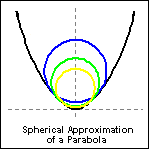
Our goal in making a telescope mirror is to figure a parabola; this is the only shape that will
accurately focus objects at optical infinity. The Foucault test can accurately measure the radius of curvature
of spheres. In using the Foucault test to measure a parabola, we approximate the parabola as a series of nested
surfaces of spheres by breaking up the surface of the mirror into a series of zones. Each zone is then measured
as if it were a section of sphere, and we use known formulas (now contained in easy to use computer programs)
to report the shape of the surface and how close it is to the desired parabola.
Zones
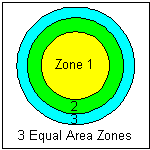
On the mirror, zones are a series of nested doughnuts with the central zone being a circle. Zones
are computed to be of equal area; therefore the central zone often looks large and the edge zone very thin (but
the edge zone is also very "long" and therefore has as much area as the the central zone and all other zones).
The practical minimum number of zones is 3; 4 or 5 is common for small mirrors; and few people use more than
7.
Zone Calculator Page
Couder Mask1
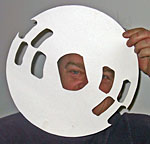 Jay looks through
Jay looks through
a 12-inch, 5-Zone Couder Mask
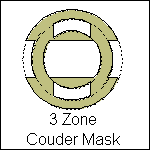
A three zone Couder Mask is shown at left. It can be made out of any stiff paper - a manila file
folder is a popular choice. Use the Zone Calculator to determine the zone edge
radii, then use a compass carefully draw these on your mask material. Using a ruler, draw two sets of parallel
lines to define the edges of the openings you will cut - make sure to leave enough material to support the mask's
interior parts. Then use a pen knife to carefully cut the zone openings.
Computer programs are available to print Couder Masks - check sites that have ATM software.
Couder Masks are the traditional method for zonal testing. They are quick and simple to make. However, the
edges of the openings show diffraction fringes while testing, and the mask hides a large part of the mirror
surface. For these reasons, some people prefer to use the Everest Pin Stick, which lessen these effects.
Reader Mr. Pinbount sent us a link for a YouTube video he made
about how to lay out a Coulder mask. He uses a computer drawing
program to do this in the video, but you could use a ruler, compass
and pencil and do it very successfully following his layout steps.
Coulder Mask Layout Video
Everest Pin Stick2
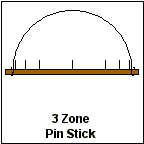
A three zone Everest Pin Stick is shown at left. Find a stick of softwood that is about 1/4"
square and an inch longer than your mirror diameter (You might try some balsa wood at a hobby shop). Mark the
center of the stick, then use the Zone Calculator to determine the zone edges
and mark them also. Then push straight pins into the stick at each mark. If you have a lot of zones, you may
want to make some pins taller than others to aid in identification. Paint the pins black to prevent glare. Finally,
make a loop from wire that will rest on the top of the mirror and hold the pin stick horizontal across the center
of the mirror.
1The Couder Masks is named for it's inventor, Andre Couder, Chief Astronomer of the Paris
Observatory.
2The Everest Pin Stick is named for it's inventor, A. W. Everest of Pittsfield, MA,
a prolific early
contributor to the ATM literature.
|